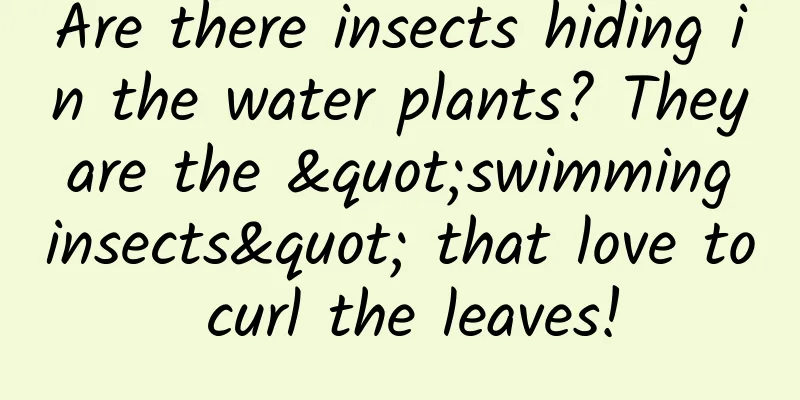Are there insects hiding in the water plants? They are the "swimming insects" that love to curl the leaves!

|
Are there insects hiding in the water plants? They are the "swimming insects" that love to roll up the leaves! When you are playing by the water and see green water plants, have you ever thought that there are insects hiding in them? In fact, most of the time, there are insects hiding in them that feed on water plants, and they can even "swim" freely in the water! The scientific name of this insect is Parapoynx diminutalis, which belongs to the order Lepidoptera, the family Pyralidae. The larvae grow in water and have a large appetite. They are good at feeding on the Hydrilla verticillata, which plays an important role in maintaining the health and stability of the ecosystem. They often stick several leaves together into a tube and hide in it (see Figure 1), so they are also called "leaf rollers" by the people. Figure 1 The camouflage of the small tube moth The life history of the small tube moth As a completely "metamorphosis" type of insect, the small tube water moth can be divided into four stages according to its morphology: larval stage, pupation stage, adult stage and egg stage. The larvae are light yellow in color and covered with bristles (Figure 2a). Before pupating, the larvae roll the leaves of the verticillata into a hollow shape and attach them to the plant stems and then pupate inside (Figure 2b). After they emerge from the wings, they become moths. The wings of the adults are white with light brown markings (Figure 2c). They usually lay eggs on emergent plants or on the water surface (Figure 2d). The entire life cycle from egg to adult is about 25-41 days. Figure 2 Life cycle of the small tube moth Hydrilla verticillata harvester The larvae of the water moth have leaf-rolling behavior and like to curl the leaves of these plants on aquatic plants. This behavior can cause the plant leaves to deform and they will eat a lot of leaves, but this will seriously affect the growth and development of the plants. In addition, the adult state of the water moth is a moth. During the flight, the moth may hatch the eggs of the water moth on nearby aquatic plants, but this will form a new source of insects and further increase the degree of harm caused by the water moth. According to the survey, 70%-80% of farmers in the main freshwater shrimp farming provinces of Hubei, Jiangsu, Guangdong and Anhui will choose Hydrilla verticillata as the breeding grass species. Therefore, for my country's aquaculture industry, the water moth has become the main pest of Hydrilla verticillata. What are the methods for preventing and controlling water moth? Biological control: This is the mainstay of control of water moth. Biopesticide strains of Bacillus thuringiensis produce proteins that are toxic to water moth larvae, which, when consumed, bind to the midgut and kill the larvae. A commercially available Bacillus thuringiensis product (Btk) has been shown to cause 80% mortality of water moth larvae in about four days. Physical control: Since the larvae and moths of the small tube water moth have strong phototropism, ultraviolet black lights and incandescent lamps can be set up for trapping and killing. However, it should be noted that since the small tube water moth has a weak phototaxis, the effect of light trapping may be unstable. Chemical control: Chemical agents can be used to control water moth. Phoxim is an organophosphorus pesticide widely used in agricultural production. It has the characteristics of high efficiency, low toxicity and broad spectrum. It is currently used in aquaculture to kill fish parasites, such as anchorhead barracuda and ringworm. Phoxim solution in the range of 0.001-10 mg/L has a toxic effect on water moth and can effectively protect Hydrilla verticillata. Author: Li Xiayu (graduate student of School of Life Sciences, Hubei University) Scientific review: Xu Letian (Professor and doctoral supervisor at Hubei University) Planning: Zhao Qingjian, Wu Yuetong Editor: Lu Jingwen (internship) |
<<: What kind of cat is this! I can't see or pet it, but I have to clean up its poop every day
>>: Can a virus be transmitted through kissing? That’s right, it’s called the “kissing virus”!
Recommend
Is the building of particle physics really going to collapse? Science magazine reveals the biggest progress in physics in recent decades
On April 7, 2022, the cover article of Science ma...
J-20, Y-20, Z-20, why are the most powerful aircraft all called 20? | Great Power Technology Fan
China's "Sky Eye", Shenzhou spacecr...
The Ditto among plants, a vine with 12 kinds of leaves?!
Look at the two leaves below. Their shapes, sizes...
The efficacy and function of rock pine
The world is full of wonders, and Chinese medicin...
The efficacy and function of the East China membrane fern
We know that there are many kinds of Chinese medi...
What ordinary people consider to be wild grass is actually a miraculous medicine for treating diseases in traditional Chinese medicine
People say that childhood is the most beautiful a...
There are always inexplicable bruises on my body. What kind of inexplicable physical phenomenon is this?
Review expert: Zhang Yuhong, chief physician of t...
Falling in love means getting shot in the head. I can’t stand the love in the animal world…
There is no shortage of bizarre sexual behaviors ...
What are the medicinal properties of Astragalus?
Astragalus is a traditional Chinese medicinal mat...
What are the benefits of eating deer antlers for women?
Because the physical fitness of female friends is...
"Twenty-four, sweep the house"! Dust and cloth, don't miss these corners →
The Spring Festival is approaching, and every hou...
Will eating noodles lead to malnutrition? 8 points to know
The summer solstice is here. In this sweaty midsu...
I was playing ham radio in the park and was mistaken for a spy
"CQCQCQ, this is BH9EMQ, calling friendly st...
The efficacy and function of the big golden knife
Diseases require improvement through medicine. Di...
Star Chart Data: In 2023, the total online consumption on Singles' Day will reach 1,138.6 billion yuan, with a year-on-year growth rate of 2.08%
The annual Double 11 e-commerce festival has come...









